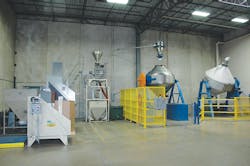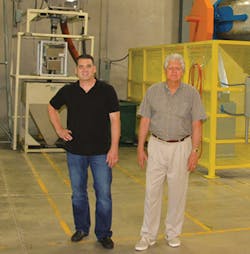AGS redefines molding of recycled plastics
An injection molder based in Batavia, Ill., is continuing to challenge the way that recycled plastics are molded into new parts. AGS Technology Inc., which makes parts for large automotive companies such as General Motors Co., constantly is tweaking and upgrading its method of direct injection molding recycled plastics, bypassing extrusion and pelletizing.
AGS recently has been awarded some significant new programs, but is sworn to secrecy by those customers. Parts made using some of AGS' latest iterations of this technology yielded the company the 2014 Supplier Quality Excellence Award from GM.
"It's hard enough to get that award using virgin materials," says AGS VP George Staniulis. "Getting that award using recycled material, this is a great testimonial from a very demanding customer."
What has been critical to the success of this process is the primary machinery and all related equipment in which compounding and injection molding are combined into one operation, says Staniulis, who gave a presentation on the topic at the Molding 2015 conference, held June 16-18 in Rosemont, Ill. The company also has become the low-cost producer of structural plastics that are nonappearance parts. It has a do-it-yourself part cost estimator, AGStimator, on its website.
"We put it out there because we have a degree of confidence that what we're doing, we're going to be the low-cost producer and we want to let everyone know," he says. "How we achieve this low cost is through recycled raw material. The business model is that instead of buying $1 per pound virgin material, we're buying recycled material at 25 cents per pound. We're doing the compounding step that is done by the compounder in an extruder, we're doing it in the injection molding machine.
"We made modifications on molding machines so that we can make the spec'd material as we mold the part," says Staniulis. "In order to do that, we have to make the modifications on our equipment."
"Right now, there are less problems because we've done some improvement with filtration. It's always a constant refining. There are new things coming out in the market. We're learning all the time, every day."
The end result is worth it, however.
"The products that we make are as good or better than a part made by [using] virgin resin," he says.
Sourcing the equipment
Finding the equipment can be its own challenge when the plastics industry is set up to use equipment designed for pellets. AGS, founded in 1995, has been refining and tweaking its process for many years. It is growing with its ever-evolving technology, adding more presses that are scheduled for delivery this month. Officials also consolidated three locations into one large location at the beginning of the year.
The new injection molding machines are from Japan Steel Works (JSW) Ltd., Tokyo, and, as with AGS' other machines, they will be equipped with the ability to run Injectoblend, the trademarked name for the recycled materials. These two presses are all-electrics. Model J450ADS is a 500-ton machine, and model J280ADS is a 310-ton machine. Officials said that the two models are the latest from JSW, with state-of-the-art clamping strength, injection precision and energy savings.
AGS often starts with new primary machines and the tweaking and modifications continue until the system is ready to process. A lot of the details of Injectoblend are proprietary, but Staniulis gave some insight. Most of the equipment was acquired through industries other than plastics.
First, the incoming material has to be blended and cleaned. The quality is unknown, there is possible contamination and there certainly is variability. The material is dustier than virgin resin.
"We identify some of these problems on the front end where we do the testing and cleaning of the raw material," he says.
The material has to be tested to predetermined incoming raw material specifications. Then the qualified raw materials are formulated to meet customer specifications. Blending equipment is used to homogenize the material.
The molds are made using good tool-building practices. AGS has its own tool standards. There can be no shortcuts, Staniulis says. The molds must have full round runners and sub-gates, good venting, uniform wall stock, and hot-runner systems that can be accessed from the front. There is increased maintenance and cleaning. The materials can outgas more than others and can therefore cause more of a buildup of varnish.
AGS has different types of loaders and conveying systems.
"It's not necessarily from the plastics industry that we find equipment that was 90 percent of what we needed and then we tweaked it," he say. "The loaders that you see for the plastics industry are basically made to convey pellets. We are conveying materials that are prone to separation — a normal vacuum-type system is not really ideal. We have more of a mechanical-type conveying system."
Dryers require larger hopper designs, especially when working with hygroscopic materials. AGS works with plastics industry suppliers for those dryers, but the hoppers have to be sized differently than what a typical molder might need. Some of the key technology is within the screw design. Over time, AGS has developed various screws. The screws need a length-to-diameter ratio as large as possible; there is a mixing section in the screw to homogenize the melt. Once the material is distributed, there still is a risk of particulate contamination. In comes a nozzle filter. AGS has taken nozzle filters that already are on the market and modified those, machining them to what officials have found works best for them.
A case in point
Injectoblend has been used in many instances. In one case, A Tier 1 supplier for interior door panels needed ideas for recycled content for the Kenworth heavy-duty line of trucks. The substrates were a good candidate for the content because they could be overmolded to meet the aesthetic requirements. The material requirements were 30 percent glass-reinforced PP with rigidity, heat resistance and dimensional stability.
The Injectoblend material performance was equivalent to virgin 30 percent glass-reinforced PP. The molded products met or exceeded all Kenworth door panel validation testing requirements, according to AGS.
Angie DeRosa, managing editor
Contact:
AGS Technology Inc., 847-534-6600, www.agstechnology.com


